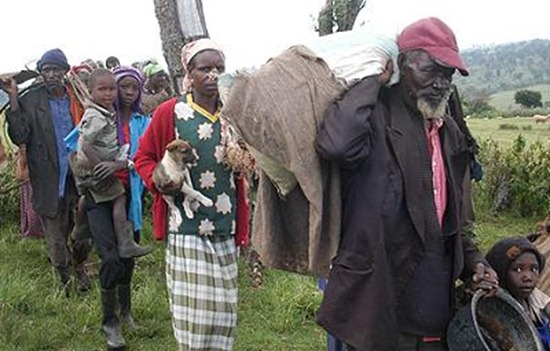Climate refugees: Mau Forest evictees in Kenya
The extraordinary forced relocation of illegal settlers from Kenya’s Massai Mau Forest Complex foreshadows the plight of climate refugees for the rest of the 21st century and beyond. Expect this kind of tragedy to be repeated many times in upcoming decades. In this case, settlers have defied Kenya law and encroached deeply into the forest to set up slash-and-burn agriculture and charcoal production. This puts enormous stress on the forest, in addition to the current historic drought. The Mau is one of the “water towers” of Kenya, and the rivers that issue from it are now bone dry. Lake Nakuru, which is fed by three rivers from the Mau, is now so shallow that it’s possible to walk across it. For an undertaking of this scale that affects so many people so profoundly, there’s surprisingly scant photographic coverage of the event. Here are a few images I’ve collected as the story has unfolded. 
The level of destruction in the western part of the Maasai Mau made it impossible to count other threats individually. However, in western part of the forest, where the pressures are much lower, it was possible to count them individually. They include:
- 1,055 heads of livestock mostly in the south and northeast;
- 36 burnt forest areas, mostly in the south and northeast (Photograph);
- 148 charcoal kilns, mostly on the lower slopes;
- 9 landslides in the northwest.
Massai Mau Forest Status Report 2005 [pdf] The River Njoro is completely dry year-round.  So the Kenya government has made the decision: no Mau Forest, no Kenya. The Mau Forest is to be rebuilt in a massive environmental restoration project, but first, the squatters must be removed. Unfortunately, separate from the illegal forest residents are the indigenous Ogiek people. The government makes no distinction between them and the illegal settlers.
So the Kenya government has made the decision: no Mau Forest, no Kenya. The Mau Forest is to be rebuilt in a massive environmental restoration project, but first, the squatters must be removed. Unfortunately, separate from the illegal forest residents are the indigenous Ogiek people. The government makes no distinction between them and the illegal settlers.  The Ogiek have protested, apparently to no avail. To my mind, this is the most tragic aspect of the whole undertaking, because we have good evidence that indigenous peoples are excellent partners in conserving their forests.
The Ogiek have protested, apparently to no avail. To my mind, this is the most tragic aspect of the whole undertaking, because we have good evidence that indigenous peoples are excellent partners in conserving their forests.  In the first phase of Mau reconstruction, 20,000 families are being moved out of the forest. In this photo, a family stands in front of their small plot, which was created by slash-and-burn deforestation. Before it was settled, this area was closed-canopy forest.
In the first phase of Mau reconstruction, 20,000 families are being moved out of the forest. In this photo, a family stands in front of their small plot, which was created by slash-and-burn deforestation. Before it was settled, this area was closed-canopy forest.  In this photo, a family stands in front of their house; the wood is made from poached Mau Forest trees.
In this photo, a family stands in front of their house; the wood is made from poached Mau Forest trees.  Some people have deeds to their land. The government is not honoring them and will not reimburse evicted families.
Some people have deeds to their land. The government is not honoring them and will not reimburse evicted families. 
 In November 2009, the evictions began. Families walked out of the forest and collected along roadsides. And waited.
In November 2009, the evictions began. Families walked out of the forest and collected along roadsides. And waited.  And waited.
And waited.  Rangers are destroying the homes of evictees, to prevent their return. Some settlers have surreptitiously re-entered the forest.
Rangers are destroying the homes of evictees, to prevent their return. Some settlers have surreptitiously re-entered the forest.  Now the Mau Forest settlers join the ranks of internally displaced people (IDPs) living in refugee camps. The UN says there may be 150 million climate refugees by 2050. I can’t find any photos of the makeshift camps that are being set up for Mau refugees, so here’s the Dadaab refugee camp in Kenya.
Now the Mau Forest settlers join the ranks of internally displaced people (IDPs) living in refugee camps. The UN says there may be 150 million climate refugees by 2050. I can’t find any photos of the makeshift camps that are being set up for Mau refugees, so here’s the Dadaab refugee camp in Kenya.  In pictures: Mau forest
In pictures: Mau forest
